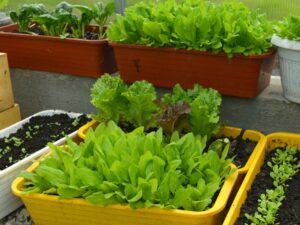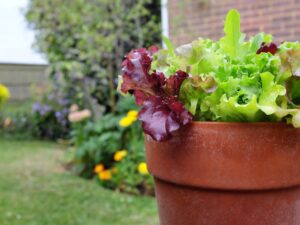By M. Bunning, F. Stonaker, A. Card, and E. Shackelton* (6/23)
Quick Facts…
- Growing your own salad greens can be a healthy, rewarding experience and a chance to try several interesting varieties!
-
Salad greens are nutrient rich, generally easy to grow, and may be used in a variety of ways.
-
Visit Food Smart Colorado for information related to the health benefits of leafy greens.
Benefits of Salad Bowl Gardening
Growing your own salad greens can provide a source of fresh, leafy vegetables with the added benefit of being able to try varieties that may not be available at local markets. When growing leafy greens, the first crop can often be harvested in just a few short weeks. In addition to salads, young leafy greens make flavorful and nutritious additions to sandwiches or wraps.
One of the joys of salad gardening is to plant seeds once but harvest leaves multiple times. Leafy greens should be trimmed carefully to avoid disturbing the roots and will re-grow additional leaves for subsequent harvests. To have a year- round supply of greens, you may want to stagger your plantings to maintain a continuous supply of harvestable leafy greens.
Whether grown outside in the soil or in a portable container, leafy greens are ideal for the cool temperatures and short seasons of Colorado, and they can be eaten at any stage of maturity.
Container Gardening
Container gardening doesn’t require much time or space – a deep tray or a few clay pots in a sunny location can provide a good supply of salad greens.
- Growing in containers can help reduce problems with insects, soil- borne diseases and poor soil conditions.
- Container gardening can provide a year-round source of fresh leafy greens since containers could be moved in order to catch more sun or shade, or transferred indoors to avoid extreme weather conditions.
Growing A Container Garden
Container
- Choose a tray, pot, or window box that is at least 18 inches across and 6 to 12 inches deep.
- Deeper pots allow more room for roots and keep the soil from drying out as quickly.
- The container can be made of clay, ceramic, plastic, or wood, but needs to have holes in the bottom and a tray or dish below to catch drainage.
- Over time, mineral deposits and other debris can accumulate on the container and may harbor disease organisms and cause problems for plants.
- To disinfect plant containers, use a stiff brush to remove soil and mineral deposits, soak in a solution of one part household bleach to nine parts water for at least 10 minutes, and rinse well with water.
Potting Mixture
Fill the container with a good quality potting mixture; some mixes are formulated to retain moisture which can be beneficial in Colorado’s dry climate.
Seeds
Leafy greens grow quickly so they can be started from seeds rather than transplants. In addition to being more economical, growing from seeds offers the opportunity to choose from the wide variety of leafy greens
- Some varieties are identified as heat tolerant and these may be good choices for container gardening.
- Common choices available for leafy greens (individually or in a mix) are lettuce, mustard greens, arugula, cress, mizuna, chervil, endive, mache, Chinese cabbage, tatsoi, escarole, garden cress, kale, and Swiss chard.
Often several flavorful, brightly colored leafy greens come as a mix in one packet. “Mesclun” means mixture and usually includes arugula, lettuce, endive, and chervil.
- Many greens, like arugula, have a tangy, peppery taste and add unique flavor.
- Red and dark green types generally are higher in nutrients and antioxidants.
Planting
When container gardening, leafy green seeds can be sown densely since they will not be maturing into full-sized plants.
- Before planting, thoroughly moisten the potting mix but not to the point of soaking wet. It’s a good idea to do this a few hours before planting.
- Scatter the seeds with about 1/2 inch spacing onto freshly prepared potting mixture. Add an additional 1/4 inch of potting mix on top.
- Water gently after planting, keeping the soil surface moist until plants emerge.
Watering and Light
- After germination, check soil moisture regularly and water, as needed.
- As the potting mixture dries, it will look and feel lighter and pull away from the sides of the container.
- Overwatering and underwatering can cause stress to young plants.
- Five or six hours of light a day is recommended but many types of salad greens can get by with less and can be grown with artificial light, partial sunlight, or even in the shade.
- Leafy greens are cool season crops and prefer temperatures below 85°F making them ideal for indoor growing.
Feeding
Depending on the available nutrients in the potting mixture and vigor of the plants, use a vegetable fertilizer and follow directions on the label.
- If needed, apply small amounts of fertilizer (half- strength) when the plants are 4 to 6 inches tall and every two weeks after that.
- For the best results, maintain a regular watering and fertilizing schedule.
Harvesting
Leafy greens may be ready for harvest in 2-3 weeks.
- When plants reach a height of four to six inches, use a pair of clean kitchen scissors or shears to cut the plants, carefully leaving behind about an inch of leafy growth.
- Cut only what you need and leave the other plants to grow, prolonging your harvest.
- Greens can also be picked leaf by leaf, usually from the time the first leaf emerges.
- When the plants start to “bolt” (sending up a seed stalk) the leaves tend to become bitter. Use bolting plants immediately to enjoy the best flavors that your garden can provide.
Storage and Preparation
Always refrigerate freshly harvested salad greens at 35°F to 40°F. Right before using, rinse thoroughly under running water and dry with a paper towel or salad spinner.
Resources & References
- 7.238 Container Gardens. Colorado State University Extension.
- 9.373 Health Benefits and Safe Handling of Salad Greens.
- 9.380 Guide to Handling Fresh Produce. Colorado State University Extension.
- Cleaning and Disinfecting Plant Containers. Iowa State University Extension, Horticulture & Home Pest News.
Visit Food Smart Colorado for more information on using salad greens.







